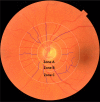Temporal changes in retinal vascular parameters associated with successful panretinal photocoagulation in proliferative diabetic retinopathy: A prospective clinical interventional study
- PMID: 29193789
- PMCID: PMC6099241
- DOI: 10.1111/aos.13617
Temporal changes in retinal vascular parameters associated with successful panretinal photocoagulation in proliferative diabetic retinopathy: A prospective clinical interventional study
Abstract
Purpose: We aimed to investigate changes in retinal vascular geometry over time after panretinal photocoagulation (PRP) in patients with proliferative diabetic retinopathy (PDR).
Methods: Thirty-seven eyes with PDR were included. Wide-field fluorescein angiography (Optomap, Optos PLC., Dunfermline, Scotland, UK) was used to diagnose PDR at baseline and to assess activity at follow-up month three and six. At each time-point, a trained grader measured retinal vessel geometry on optic disc (OD) centred images using semiautomated software (SIVA, Singapore I Vessel Assessment, National University of Singapore, Singapore) according to a standardized protocol.
Results: At baseline, the mean age and duration of diabetes were 52.8 and 22.3 years, and 65% were male. Mean HbA1c was 69.9 mmol/mol, and blood pressure was 155/84 mmHg. Of the 37 eyes with PDR, eight (22%) eyes had progression at month three and 13 (35%) progressed over six months. Baseline characteristics, including age, sex, duration of diabetes, HbA1c, blood pressure, vessel geometric variables and total amount of laser energy delivered did not differ by progression status. However, compared to patients with progression of PDR, patients with favourable treatment outcome had alterations in the retinal arteriolar structures from baseline to month six (calibre, 154.3 μm versus 159.5 μm, p = 0.04, tortuosity 1.12 versus 1.10, p = 0.04) and in venular structures from baseline to month three (fractal dimension 1.490 versus 1.499, p = 0.04, branching coefficient (BC) 1.32 versus 1.37, p = 0.01).
Conclusion: In patients with PDR, successful PRP leads to alterations in the retinal vascular structure. However, baseline retinal vascular geometry characteristics did not predict treatment outcome.
Keywords: NAVILAS; SIVA; clinical; computer-assisted; humans; panretinal photocoagulation; proliferative diabetic retinopathy; prospective; retinal vessel geometry.
© 2017 The Authors. Acta Ophthalmologica published by John Wiley & Sons Ltd on behalf of Acta Ophthalmologica Scandinavica Foundation.
Figures


Similar articles
-
Retinal arteriolar calibre and venular fractal dimension predict progression of proliferative diabetic retinopathy 6 months after panretinal photocoagulation: a prospective, clinical interventional study.BMJ Open Ophthalmol. 2021 Mar 22;6(1):e000661. doi: 10.1136/bmjophth-2020-000661. eCollection 2021. BMJ Open Ophthalmol. 2021. PMID: 33786381 Free PMC article.
-
Peripheral capillary non-perfusion in treatment-naïve proliferative diabetic retinopathy associates with postoperative disease activity 6 months after panretinal photocoagulation.Br J Ophthalmol. 2019 Jun;103(6):816-820. doi: 10.1136/bjophthalmol-2018-312195. Epub 2018 Aug 1. Br J Ophthalmol. 2019. PMID: 30068515 Free PMC article.
-
Optical coherence tomography angiography reveals progressive worsening of retinal vascular geometry in diabetic retinopathy and improved geometry after panretinal photocoagulation.PLoS One. 2019 Dec 30;14(12):e0226629. doi: 10.1371/journal.pone.0226629. eCollection 2019. PLoS One. 2019. PMID: 31887149 Free PMC article.
-
A meta-analysis to study the effect of pan retinal photocoagulation on retinal nerve fiber layer thickness in diabetic retinopathy patients.Rom J Ophthalmol. 2020 Jan-Mar;64(1):8-14. Rom J Ophthalmol. 2020. PMID: 32292851 Free PMC article. Review.
-
Implication of Deep-Vascular-Layer Alteration Detected by Optical Coherence Tomography Angiography for the Pathogenesis of Diabetic Retinopathy.Ophthalmologica. 2019;241(4):179-182. doi: 10.1159/000495624. Epub 2019 Jan 16. Ophthalmologica. 2019. PMID: 30650416 Review.
Cited by
-
Advances in Research Related to MicroRNA for Diabetic Retinopathy.J Diabetes Res. 2024 Feb 12;2024:8520489. doi: 10.1155/2024/8520489. eCollection 2024. J Diabetes Res. 2024. PMID: 38375094 Free PMC article. Review.
-
Retinal arteriolar calibre and venular fractal dimension predict progression of proliferative diabetic retinopathy 6 months after panretinal photocoagulation: a prospective, clinical interventional study.BMJ Open Ophthalmol. 2021 Mar 22;6(1):e000661. doi: 10.1136/bmjophth-2020-000661. eCollection 2021. BMJ Open Ophthalmol. 2021. PMID: 33786381 Free PMC article.
-
A narrative review of retinal vascular parameters and the applications (Part I): Measuring methods.Brain Circ. 2023 Sep 27;9(3):121-128. doi: 10.4103/bc.bc_8_23. eCollection 2023 Jul-Sep. Brain Circ. 2023. PMID: 38020955 Free PMC article. Review.
-
Longitudinal changes in retinal microvasculature after panretinal photocoagulation in diabetic retinopathy using swept-source OCT angiography.Sci Rep. 2021 Jan 8;11(1):216. doi: 10.1038/s41598-020-80697-0. Sci Rep. 2021. PMID: 33420291 Free PMC article.
-
The relationship between diabetic retinopathy and psychosocial functioning: a systematic review.Qual Life Res. 2019 Aug;28(8):2017-2039. doi: 10.1007/s11136-019-02165-1. Epub 2019 Mar 16. Qual Life Res. 2019. PMID: 30879245
References
-
- Armstrong RA (2013): Statistical guidelines for the analysis of data obtained from one or both eyes. Ophthalmic Physiol Opt 33: 7–14. - PubMed
-
- Broe R, Rasmussen ML, Frydkjaer‐Olsen U et al. (2014a): Retinal vessel calibers predict long‐term microvascular complications in type 1 diabetes: the danish cohort of pediatric diabetes 1987 (DCPD1987). Diabetes 63: 3906–3914. - PubMed
-
- Broe R, Rasmussen ML, Frydkjaer‐Olsen U, Olsen BS, Mortensen HB, Peto T & Grauslund J (2014b): Retinal vascular fractals predict long‐term microvascular complications in type 1 diabetes mellitus: the Danish Cohort of Pediatric Diabetes 1987 (DCPD1987). Diabetologia 57: 2215–2221. - PubMed
-
- Cheung CY, Hsu W, Lee ML et al. (2010a): A new method to measure peripheral retinal vascular caliber over an extended area. Microcirculation 17: 495–503. - PubMed
-
- Cheung N, Mitchell P & Wong TY (2010b): Diabetic retinopathy. Lancet 376: 124–136. - PubMed
Publication types
MeSH terms
Grants and funding
LinkOut - more resources
Full Text Sources
Other Literature Sources
Medical
Research Materials

